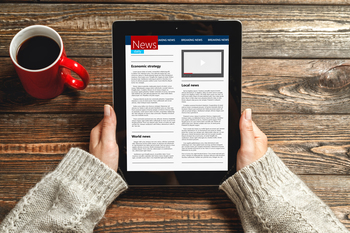SEMA News—August 2020
BUSINESS
New Strategies for Automotive Print Publications
How Old-School Media Can Stay Competitive in the Digital Era
 A recent industry survey showed that more than 90% of Americans reported looking at a magazine within the previous six months, with respondents 35 and younger reporting an even higher engagement level. |
Last December, Motor Trend Group—then North America’s premier publisher of automotive enthusiast magazines—announced that it was shuttering 19 of its remaining 22 print titles. In the announcement, company President and General Manager Alex Wellen provided a simple explanation.
“We need to be where our audience is,” Wellen said, and that audience no longer relied on traditional print media as its primary source of news and information. “Tens of millions of fans visit Motor Trend’s digital properties each month, with the vast majority of consumption on mobile and three out of every four visitors favoring digital content over print.”
With that, a print-centric media company that for decades had published dozens of iconic enthusiast titles such as Hot Rod, Truckin,’ Circle Track and Diesel Power had effectively transformed itself into an all-digital content producer. In turn, the news confirmed what many automotive industry professionals had long suspected: Twentieth Century marketing and messaging strategies that had relied heavily on print media were no longer operative in the 21st.
Or were they?
For this article, we contacted representatives of more than a dozen automotive media companies to learn how they have adapted to the changing landscape and to discover which marketing and communications strategies have worked best for them. What follows is a compilation of their insights.
 There was general agreement among our sources on the need for print magazines to build the capability to deliver content across a variety of platforms in a way that puts that platform to best use—long form for print, short form for digital, visuals for social media—with a unique look and feel to each. |
Readership and Revenue: Making the Connections
For an industry long rumored to be near death, print magazines still possess a near-universal appeal among the general public. According to a 2019 survey published by MPA—the Association of Magazine Media, more than 90% of Americans reported having read at least one magazine within the previous six months—a figure that was consistent across all age groups. Among respondents under age 35, the percentage was slightly higher than
the median.
Additionally, 73% of respondents felt that reading a printed magazine (or book) was a more enjoyable experience than reading on an electronic device. Print magazines also enjoy a “pass-along” rate that e-zines don’t, with an average issue being read by 2.5 persons, according to Top Agency, a global public-relations and marketing firm.
“There are people who have screen fatigue and who just want to have the experience of immersing themselves in a physical product,” said Sean Holman, content director at MotorTrend Group and co-host of “The Truck Show Podcast.” “It’s no longer the right place for breaking news but rather a fantastic platform for those long-form stories with beautiful photography and exceptional storytelling.”
While the market for print magazines may have contracted overall, the 2019 MPA study showed that automotive influencers (defined as people who have extensive experience in the topic and whose advice on the topic is trusted by friends and family members) are more devoted to automotive print magazines than to any other form of automotive media, suggesting that there is still a loyal enthusiast core waiting to be served by print.
And all of our sources agreed that print still has a place in a media company’s business portfolio.
“Print isn’t dead—it has just been mismanaged and overleveraged throughout the years and has fallen out of favor due to the immediacy of digital, both in advertising and content,” Holman said. “Print is still one of the more highly engaging platforms, and if you can make the business model work, now is the time to gain market share.”
”Our strategy is to place content where our audience wants to engage with it,” said Sean Donohue, vice president of sales at Babcox Media. “We know that is still a monthly magazine for some segments, and it’s within e-newsletters, on websites, videos, podcasts and the like for others.”
Bo Sacks, president of Precision Media Group and an industry consultant, said that print will continue to have a soft spot in the hearts of many, adding that magazines in the future are likely to become collectors’ items—perhaps one of the last products made by craftsmen for an audience that appreciates such excellent work.
At the same time, Sacks said, printed products will take a back seat to the digital communication business because, at the end of the day, digital is and will be faster, timely and ubiquitous.
“Most magazine publishers have been relying on a centuries-old business plan,” Sacks said. “The idea was to develop content for a set of readers and get advertising to support the process. That worked until it didn’t, and it stopped being fully functional a decade ago. If you are still working with an antique business model a decade later, perhaps it is time to look around and change it.”
One editorial strategy that several sources found advisable for future success was for media companies to steer away from traditional general-interest publications in favor of so-called niche publishing, which means focusing a brand’s editorial aim on an underserved readership with coverage of a subject that isn’t readily available elsewhere. In fact, so-called special-interest magazines are the fastest-growing segment in the industry, according to a 2018
report published by Statista, a global data analysis firm.
Overland Journal is one such publication within the automotive sphere, and its success has mirrored the growth of the overlanding sector.
“Our circulation has increased more than 21% in the past 12 months,” said Publisher and Chairman Scott Brady. “Overlanding is one of the fastest growing segments in travel, automotive and outdoor, so our growth may not be representative of print as a medium but of the health of the segment.”
 According to our sources, social media can be an effective tool to build a magazine’s brand identity, but publishers should take care to invest in more conventional promotional streams as well. According to our sources, social media can be an effective tool to build a magazine’s brand identity, but publishers should take care to invest in more conventional promotional streams as well. |
Print advertising revenue, while continuing to decline relative to digital, still generated more than $9 billion in 2019, according to a recent survey by data and research firm eMarketer. Additionally, more than 60% of total media-magazine advertising revenue and more than 85% of all circulation revenue was still generated by legacy print, according to a 2016 study conducted by PriceWaterhouseCoopers. A 2019 Statista survey reported aggregate annual revenues for U.S. print periodicals of $27.3 billion, suggesting that the industry still enjoys a respectable level of consumer support.
Sacks noted that business people and venture capitalists mistake a change in dominance for death, but it’s not equivalent to death.
“It just looks and feels that way after 600 years of domination,” he said. “Billions are still being made in print, and there will be billions made in print for the foreseeable future.”
One attribute that can make a print title attractive to advertisers is, in many cases, its reputation as a proven brand, though it’s not a universal attraction.
“It all depends on the advertiser,” said Turn 3 Media managing partner Joe Tripp, adding that many advertisers still want print because they trust it.
That attribute seems to be confirmed by the 2019 MPA survey, which found that traditional media enjoyed the highest levels of public trust as a source for accurate news and information with 65% approval, followed by search engines (63%), owned media (53%), social media (49%) and online-only media (43%). According to the same survey, magazine readers also tend to be more receptive to advertising and more brand-loyal than website visitors or TV viewers.
Another characteristic of print that should continue to attract advertisers is print’s appeal to a reader demographic with a healthy degree of disposable income. The MPA survey found that affluent enthusiasts (defined as individuals over 18 with incomes of more than $125,000 or households with combined incomes of more than $250,000) were more likely to rely on print magazines to keep them informed and entertained than on any other form of automotive media.
“We have known for some time that premium, archival print titles perform well, as they connect with a more affluent readership and are also shared or kept,” Brady concurred.
With so many media avenues available for advertisers and readers alike, monetizing print magazines in the digital age requires a flexible business model and a product that delivers value to readers.
“For print, we believe that it is essential to be 100% reader-focused,” Brady said. “In our case, that includes comprehensive and expensive product testing that has value in the same way that a Consumer Reports [evaluation] does. As a result, we can charge a premium subscription fee. In addition, we do not permit any form of advertorial in any of our outlets, which maintains reader trust.”
 It may be considered passé in some quarters, but a number of our sources mentioned podcasting as an effective, low-cost method to engage readers and build brand awareness for print titles. |
Digital and Social Media as Part of the Business Model
One key to building and maintaining a viable print brand in a multimedia age is understanding how to position print content relative to other media streams within the publishing business.
Tripp put it succinctly: “Print is more for long-form, evergreen content, while digital is for breaking news, video and interactive media. Social media is attention-getting short-form content that people will engage with, and each form complements
the other.”
“Print should be inspirational, while digital should be aspirational.” Brady added.
Our sources also widely agreed that print magazines need to have a robust digital presence, with rich, engaging content available for PC, tablet and smartphone.
“Digital communication methods permit immediacy, which is something that print cannot compete with,” Brady noted.
Social media and e-newsletters can both be valuable marketing tools.
“They’re our most successful drivers of new users to content on our website,” Tripp said. “Once a reader sees the value in the content, many are easy to convert to seeing the value of a tactile, printed product.”
Knowing which social-media platforms to target is as important as having a social-media presence.
“As my brands are so visual, we focus primarily on Instagram,” Brady said. “We use all of the channels, but only as a marketing exercise.”
Holman noted that it’s really age-dependent.
“Younger audiences seem to gravitate toward Instagram,” he said. “Older audiences engage more on Facebook, and YouTube is a place for everyone.”
Tripp said that his business primarily uses Facebook for supporting its advertising clients and Twitter for news.
Social-media users also tend to be more drawn to automotive-magazine pages than non-magazine automotive pages when measured by levels of social engagement (defined as social media actions divided by publisher’s posts). According to the 2019 MPA survey, automotive magazine brands (e.g., Car & Driver, Hot Rod) generated nearly twice the amount of user engagement on Facebook as non-magazine brands (Autoblog, Edmunds). On Twitter, engagement was two-and-a-half times greater, and 31 times greater on Instagram. But Brady also cautioned against relying too heavily on social media for
brand promotion.
“The primary issue is that you do not own the distribution model or the reader,” he noted. “You are playing entirely in someone else’s sandbox, which is not a model I find appropriate for a media company that produces original content. The possible exception to this would be video, if the content is a pay-per-view model such as Netflix or Amazon.”
Sacks reminded publishers not to overlook older, more conventional brand-building methods.
“As strange as it may seem, you get readers two ways,” he said. “One is word of mouth from happy readers or clients, and the other is traditional marketing, depending on the type of product you have. The best regional magazines spend a fortune on TV, radio and newspaper inserts. Why? Because they work. That may seem old school, but I know too many publishers who have spent wisely, and it is working. The old adage is still true: You have to spend money to make money.”
Among other forms of digital media, video consumption continues to be on the rise, according to Donohue.
“As a result, we’re placing significant resources serving our audience with a variety of video and broadcast solutions,” he said. “We opened a garage studio and training center late last year and are utilizing our space and technology to produce valuable content for our markets as well as digital opportunities for our advertisers to drive engagement.”
A number of our sources also mentioned podcasting as an effective and economical way to engage readers online.
“It seems to be a new space where you can extend the storytelling and go deeper into a subject to capture those readers who really want more,” Holman said.
Another recommended key to success for publishers going forward is using modern analytics tools to understand the different behaviors of magazine readers and digital-media users to best optimize engagement.
“We use traditional survey methodology and advanced analytics to gain deeper insights and make predictions about where content or advertising messages will perform best,” Donohue said. “We listen to our audience, recognizing that even across our portfolio, consumption habits may vary, which could mean adjusting our content delivery plans and advertiser recommendations by brand.”
Holman added that content needs to be platform-agnostic, and print needs to be one of multiple pillars of distribution.
“The danger is in creating the exact same content for online versus print,” he said. “A single story should be formatted, adjusted and tweaked so there is a version of the story that is optimized for each destination.”
For magazines to thrive, however, our sources uniformly agreed that producing the highest-quality content was an essential part of the business model.
“If you haven’t created unique and addictive content for your niche, the decline will continue to accelerate,” Sacks advised. “There is no longer any room to print fluff. The content has to have a purpose and relevancy to the reader, or they will go elsewhere. It is that simple and that hard to do. Print isn’t dead or dying, but it is evolving from a commodity to a luxury. As a luxury, there will be much less of it, but what is left will be of extremely high quality in both the physical product and the editorial content.”
Holman believes that there will come a point “where quality print will be en vogue again, both by readers who need time away from their screens and by advertisers who realize that the print option isn’t as noisy of a space to compete in anymore, has better engagement, and allows them to get their message out to a qualified audience.”
To that end, today’s print publishers should strive for, as Tripp explained, “a targeted focus for a passionate audience; rich, authentic content that both informs and entertains; and cross-platform continuity that allows readers to consume content on their terms, wherever and whenever they want. Content and context are king.”
 A simple and cost-effective brand-building tool, the SEMA Show Magazine Bin Program puts publishers directly in touch with the more than 150,000 industry pros who attend the Show each year. |
About the SEMA Show Magazine Bin Program
One additional resource that magazine publishers can utilize to build brand awareness within the aftermarket is the SEMA Show Magazine Bin Program. More than a decade old, the program allows publishers to display their magazines at the Show in exchange for nominal advertising promotion, and more than 100 titles, both foreign and domestic, participate in any given year, making their brands available to the more than 150,000 industry professionals who attend annually.
Domestic publications interested in getting more information or participating in the program can visit www.SEMAShow.com/domestic-bin-program. International publications interested in getting more information or participating in the program can visit www.SEMAShow.com/international-ad-trade-out.






